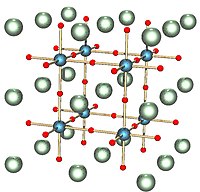
Photo from wikipedia
In recent years, two-dimensional Ruddlesden-Popper (2DRP) perovskite materials have been explored as emerging semiconductor materials in solar cells owing to their excellent stability and structural diversity. Although 2DRP perovskites have… Click to show full abstract
In recent years, two-dimensional Ruddlesden-Popper (2DRP) perovskite materials have been explored as emerging semiconductor materials in solar cells owing to their excellent stability and structural diversity. Although 2DRP perovskites have achieved photovoltaic efficiencies exceeding 19%, their widespread use is hindered by their inferior charge-carrier transport properties in the presence of diverse organic spacer cations, compared to that of traditional 3D perovskites. Hence, a systematic understanding of the 2D perovskite's carrier transport mechanism is critical for the development of high-performance 2D perovskite solar cells (PSCs). In this review, we summarize the recent advances in the carrier behavior of 2DRP PSCs and provide guidelines for successfully enhancing carrier transport. First, we discuss the composition and crystal structure of 2DRP perovskite materials that affect carrier transport. Then, we evaluate the features of 2DRP perovskite films (phase separation, grain orientation, crystallinity kinetics, etc.), which are closely related to carrier transport. Next, we reveal the principal direction of carrier transport guiding the selection of the transport layer. Finally, we propose an outlook and rationalize strategies for enhancing carrier transport in high-performance PSCs. This article is protected by copyright. All rights reserved.
Journal Title: Advanced materials
Year Published: 2021
Link to full text (if available)
Share on Social Media: Sign Up to like & get
recommendations!